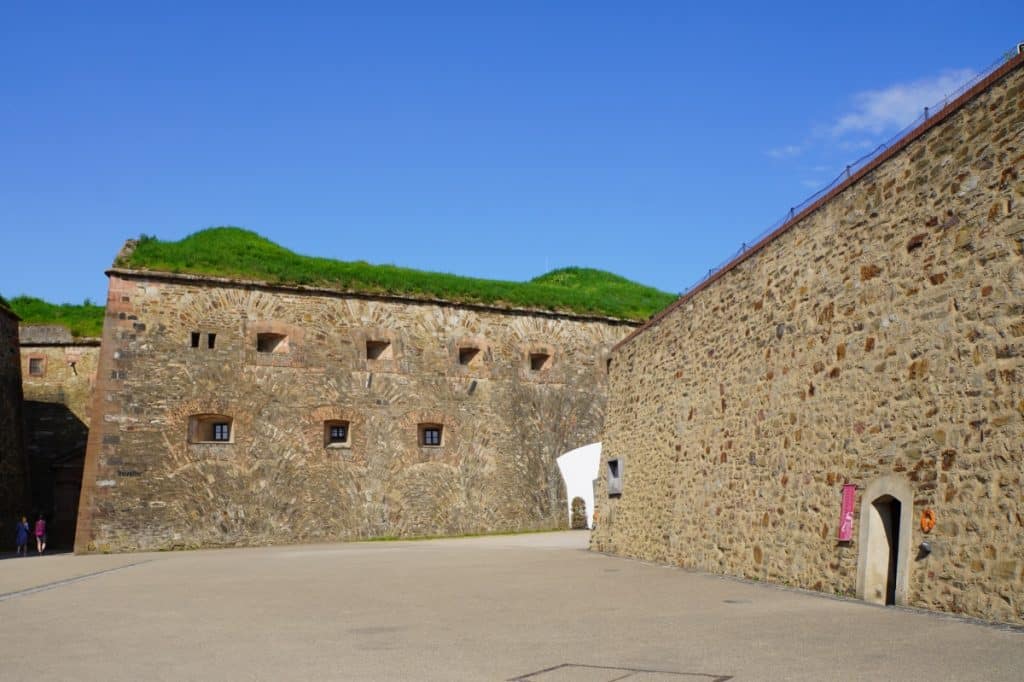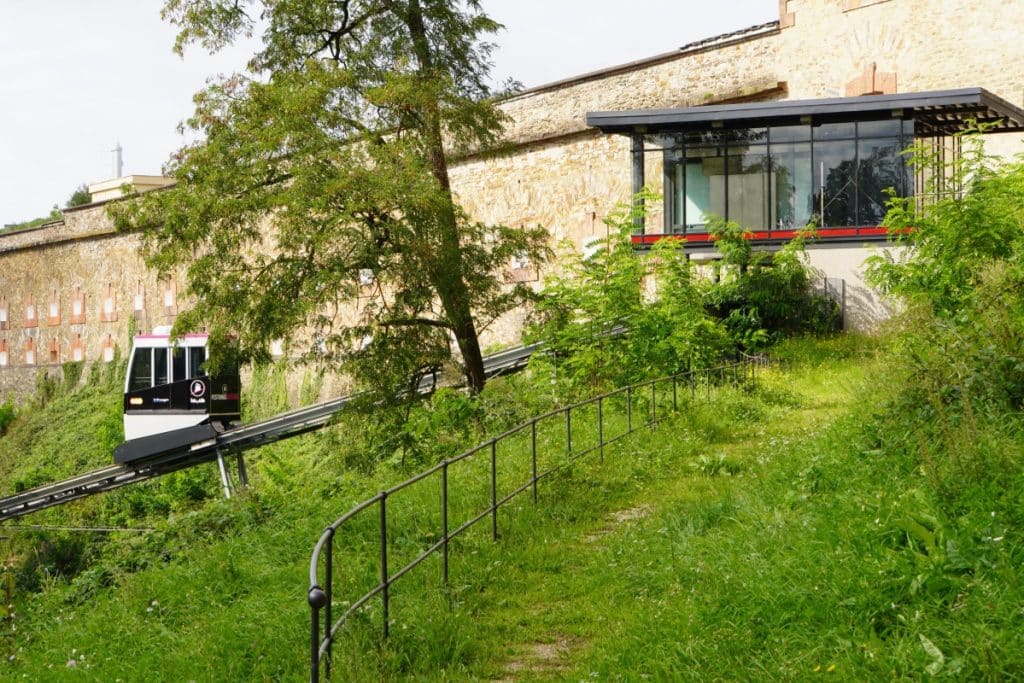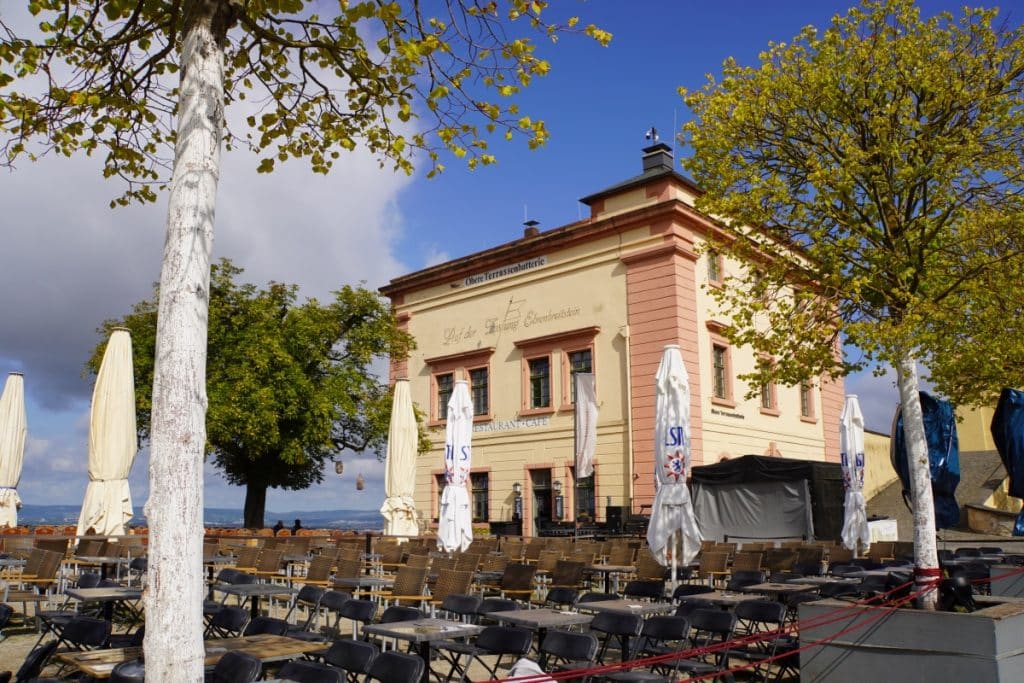The cable car from Koblenz reaches the top station and we get off. High above the city, on the right side of the Rhine, lies Ehrenbreitstein Fortress on Mount Ehrenbreitstein. It already looks big and mighty from the Rhine valley, but we will explore whether it is really that impressive.

We get off the cable car and first we are drawn across a large open space, which is part of the former BUGA site, to a viewing platform.
Free vantage point on Koblenz
The viewing platform was built for the BUGA. It can be visited free of charge. We reach the highest point of the observation tower via a ramp that slowly winds upwards, and a breathtaking view of the surroundings opens up before us.

Directly in front of us, the Moselle flows into the Rhine. We can watch ships sailing across the rivers – large cargo ships and river cruise ships can be seen. It is particularly exciting when one of these huge ships “turns” into the Moselle coming from the Rhine. The current of the water pushes the ship around at an amazing speed. The captain will have a lot to do on his bridge to prevent the ship from being pushed into the embankment.

There is not only a lot to discover on the water. We can also see interesting places on land. There is the Lützel district of Koblenz on one side of the Moselle and the old town of Koblenz on the other. Both areas are connected by bridges over which numerous cars, trains, cyclists and pedestrians change sides of the river every day.

In the district of Lützel we discover the remains of the Kaiser Franz fortress, which was closely connected to the Ehrenbreitstein fortress. Unfortunately, not much remains of this fortress after it was blown up.

On the opposite side of the Moselle, above the main railway station, lies another fortress complex, which can be easily seen from the viewing platform. The fortress of Grand Duke Constantine is much better preserved and formed another strategically important site in the defence of the region.

Certainly, however, the most important place that every visitor wants to see is the German Corner. The monument to Emperor Wilhelm stands tall and mighty here.
From this free vantage point over Koblenz you really have a great view. After getting an overview of the city, we were drawn to Ehrenbreitstein Fortress.
Location of Ehrenbreitstein Fortress
The fortress is located on a 180-metre-high mountain spur whose rocky slopes lie directly on the Rhine valley. This location made the fortress almost impregnable. On three sides (south, east, west), high steep slopes prevented the enemy from reaching the complex. Only the plateau in the northeast had to be strongly defended.
Origin of the fortress
Around the year 1000, there must have already been a castle on Ehrenbreitstein. The first mentions of it date back to this time. For a time, this complex was the residence of the prince-bishops of Trier. Even at that time, it was considered the safest castle in the region and important shrines of the country were kept there.

In the early 16th century, Archbishop Richard von Greiffenklau zu Vollrads had the castle expanded into a fortress. In this way, he wanted to ensure the protection of the complex despite the constantly developing war technology. Greiffenklau also had the first cannon cast for the fortress, which can be seen in the museum today.

In 1794, French revolutionary troops captured the city of Koblenz in the First Coalition War and besieged the fortress four times from 1795. Almost starved to death, they surrendered the fortress to the French in 1799 after a good year of blockade. Only a short time later, the French were forced to abandon the right bank of the Rhine and thus the fortress as well, due to a peace plan. In 1801, shortly before their withdrawal, they blew up the fortress so as not to have to hand it over to the enemy. Unfortunately, Philippsburg Castle below the fortress suffered so much damage from the blast that it had to be demolished.
New construction of the fortress by the Prussians
After the Congress of Vienna, the area around Koblenz is awarded to the Kingdom of Prussia. King Frederick William III issued the order to refortify the city and Ehrenbreitstein Fortress in 1815. This led to a flurry of construction activity over the next few years, creating one of the most extensive and modern fortification systems in Europe.

On the Ehrenbreitstein, the remains of the destroyed complex were used to build a large citadel. The Prussian engineer Carl Schnitzler was responsible for the planning and implementation. The result was a defence system that could withstand all weapons and types of attack known at the time. In the event of war, 1500 soldiers with 80 guns were to defend the Ehrenbreitstein. The soldiers were exclusively professional soldiers and conscripts, who also lived there in new casemates. The accommodation was quite modern for the time, with stove heating, windows and their own beds.

In addition to its military use, part of the complex also served as a prison. From the 1830s until 1909, officers and civilians served fortress arrest or imprisonment.
The fortress was in active service until 1890. However, as war technology continued to develop, those responsible decided to discontinue its use.

After the First World War, the Treaty of Versailles actually stipulated that the fortress should be demolished. Fortunately, the cultural value of the fortress was recognised and it was not demolished. During the Second World War, art objects and archives from Koblenz, Cologne and Wuppertal were stored in the casemates. However, these did not offer sufficient protection and so the objects were brought to safety in other places. Koblenz was 87% destroyed in this war, but the fortress suffered hardly any damage. In early 1945, US soldiers occupied Ehrenbreitstein Fortress, and later the French army moved in.
And today?
The fortress complex is the property of the state of Rhineland-Palatinate. Not only is the Koblenz State Museum located here, but also a youth hostel. Events are held on the grounds and, of course, you can visit the old walls.

Since 2002, Ehrenbreitstein Fortress has been part of the UNESCO World Heritage Site “Upper Middle Rhine Valley” and a protected cultural monument.
What can you see in Ehrenbreitstein Fortress?
After passing through the turnstile at the entrance to the fortress, we followed a slightly sloping path to the field gate that led us behind the truly imposing walls. From now on, it was time to go exploring.
We didn’t follow a plan, we didn’t have a fixed destination, we just wanted to explore and let the huge complex take its effect on us. It was only here that we really realised how big Ehrenbreitstein Fortress is. Behind the walls are courtyards, buildings, corridors and, above all, a wonderful view of the Rhine, Moselle and Koblenz at various points. We were on the road for 3 hours and only saw part of the exhibitions. So if you visit the fortress, you should bring some time with you.


Right next to the field gate is the tower Unnamed. I must admit that I really looked up the name several times because it is so unusual. According to an anecdote, the name came about like this: in 1821, the Prussian prince and the Russian tsar’s son were involved in the construction. It was decided that the tower should be named after one of the two noblemen. Each wanted to give the other precedence and so they finally agreed on the compromise “Tower Unnamed”. Today’s earth-covered tower has four storeys, with nine gun casemates on each of three of the storeys (except for the cellar).

Right here at the beginning of our tour, we also visited an exhibition about the origins of the fortress. I found the models of the fortress from the different eras very impressive and they show the proportions very well.
The path leads past an elongated two-storey casemate building. Through a corridor, we then entered the complex further. For someone who knows next to nothing about fortress construction, it was very nice to read the names of the structures and courtyards on the buildings. Every now and then we discovered an overview map that told us where we were. This was quite good for me, because after a short time I wouldn’t have been able to pinpoint our location. I was far too distracted by the mighty buildings around me.

Arriving at the upper courtyard of the castle, we reached a viewing terrace from which one can enjoy a wonderful view over Koblenz. Some of the buildings around this courtyard no longer seemed to me as if we were in a fortress. Here, you could also be standing in a castle courtyard surrounded by buildings with classicist façades. From this square you can also reach the youth hostel, which uses areas of the fortress complex. This can also be reached comfortably outside opening hours with the help of an inclined lift that ends in front of the fortress walls.

On our foray through the impressive grounds, we also visited some of the exhibition rooms that deal with a wide variety of topics. For example, there is a very interesting archaeological collection in the “House of Archaeology”, which houses the permanent exhibition “Geborgene Schätze. Archaeology on the Middle Rhine and Moselle”.
There is also an exhibition on the subject of wine. This is located in the “House of Pleasure” in the “Lange Linie”.

We discovered former prison cells and guardrooms from the Prussian era. Rather by chance, we also passed some rooms that show what flats in the fortress looked like in the 1950/60s.
Is it worth the visit?
In our opinion, definitely! What a huge building, what a view over the city… I didn’t expect that and it impressed me a lot.
And after the visit…..
A tip from us. If you take the inclined lift down from the castle and take a short walk, you will reach the Göhlen Winery (Mühlental 33, 56077 Koblenz-Ehrenbreitstein). A visit to the wine cellar and a wine tasting are possible here by appointment.

Address Ehrenbreitstein Fortress:
Felsenweg,
56077 Koblenz
Opening hours:
01.04. – 05.11.2023: 10-18 h
Admission prices:
Adults: 8,-€
Discounts are offered.
Cable car + fortress:
Adults: 19,-€
Discounts are offered.
The visit to the fortress took place within the framework of a press trip with the Koblenz-Touristik GmbH .









Leave a Reply